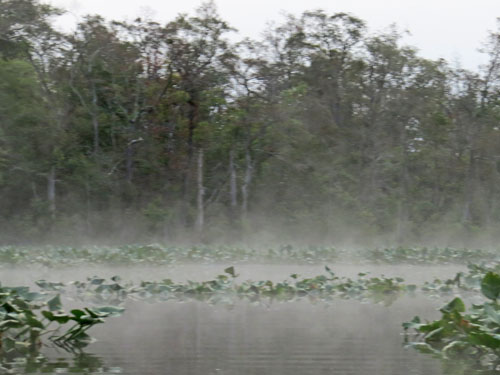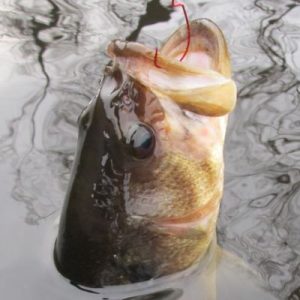
Fishing around lily pads (spatterdock) can be challenging, but productive. Spatterdock, commonly known as lily pads, yellow water lily, cow lily, or pond lily is a type of aquatic plant is found throughout Eurasia and North America.
Spatterdock occurs in both freshwater and brackish habitats and is often found in tidal rivers, creeks, and swamps.
Spatterdock often grows in large colonies, with plant roots fixed into the mud and leaves floating on the water’s surface.
In spring, the plants send shoots up and leaves grow until they are high enough to float on the surface. The leaves remain until fall when they begin to deteriorate.
These unique environments attract a number of organisms, including insects, invertebrates, amphibians, reptiles, birds, fish, and aquatic mammals.
Spatterdock habitats may contain a range of fish, depending on the region and season. In most areas largemouth bass, black crappie, sunfish, chain pickerel, northern snakeheads, yellow perch, gar, catfish, and other species all orient to lily pad colonies.
Several lures are effective in these areas including soft frogs, weedless spoons, salamanders, jerk baits and soft plastics such as Senko worms. During the early season, the plant stems are softer and more forgiving if a lure becomes fouled, but as the season goes on, weedless lure designs are essential.

Perhaps the most sought-after fish when fishing lily pads is the largemouth bass. These heavyweight eating machines lurk along the edges of pads, ready to ambush anything that moves.
Bass anglers sometimes work pads in pairs, with one angler fishing a loud surface bait while the other angler fishes deeper areas just off the border of pads.
One essential lure for targeting largemouth along lily pads is the soft-bodied weedless frog. This odd looking lure has many variations, but most share a few common traits.
A good frog will float effortlessly, have a soft body and hooks that are well protected snagging on weeds. Most weedless frogs hook fish when they bite down hard, which exposes hooks that are hidden inside.
Due to their weedless design, hookups can be more difficult to achieve using frog lures than some other bass lures. Despite this, most anglers love using them. Much of the allure of these baits comes from the spectacular strikes that they incite.
Often largemouth bass or other predators will charge after a frog lure as it skips across aquatic vegetation, finally exploding on the lure when it reaches open water. Fish that do not get hooked often strike repeatedly, showering the angler with water.
When rigged weedless, soft bodied salamanders, stick baits, paddletails, and other soft plastics can be successfully worked across lily pads. For fishing the edges of vegetation, buzz baits, chuggers, poppers, and other surface lures can be effective. Weedless designs provide a higher amount of fishing time but some of the classic topwater lures are also useful for inciting strikes when bass become finicky.
In addition to largemouth bass, anglers sometimes target chain pickerel around colonies of spatterdock. These vicious predators prefer to lurk in dense vegetation or orient to logs or other structure. Their attack happens at lightning speed, ambushing small fish or other prey. Pickerel anglers take advantage of this, working weedless lures across the pads and into openings where pickerel await.
Many of the same lures that work for largemouth bass also work for pickerel. Losses of lures must be expected as pickerel have razor sharp teeth and often cut the line during the strike. Some anglers avoid treble hooks when fishing for pickerel as the fish are known for leaping and shaking lures loose.
In addition to artificial lures, anglers occasionally fish live baits along lily pad beds. Several rigs are effective, among them are traditional bobber rigs, jig-minnow combinations or a simple unweighted leader armed with a circle hook. Fishing minnows or other live baits along the edges of lily pads is an excellent technique when kayak fishing.
A popular technique for fishing live baits among pads is the use of cane poles or crappie poles. These specialized setups employ a long rod or bamboo pole, with a simple line extending from the tip. Anglers working from the shore or from small boats simply lower a bait into openings among the pads.
When a strike is felt, the angler must lift the rig vertically, pulling the fish out of the water. If there is any hesitation, the fish will be lost among the dense cover.
Regardless of the technique, fishing around lily pads can be extremely productive. As the season progresses, anglers often employ a series of techniques around these aquatic plant habitats.